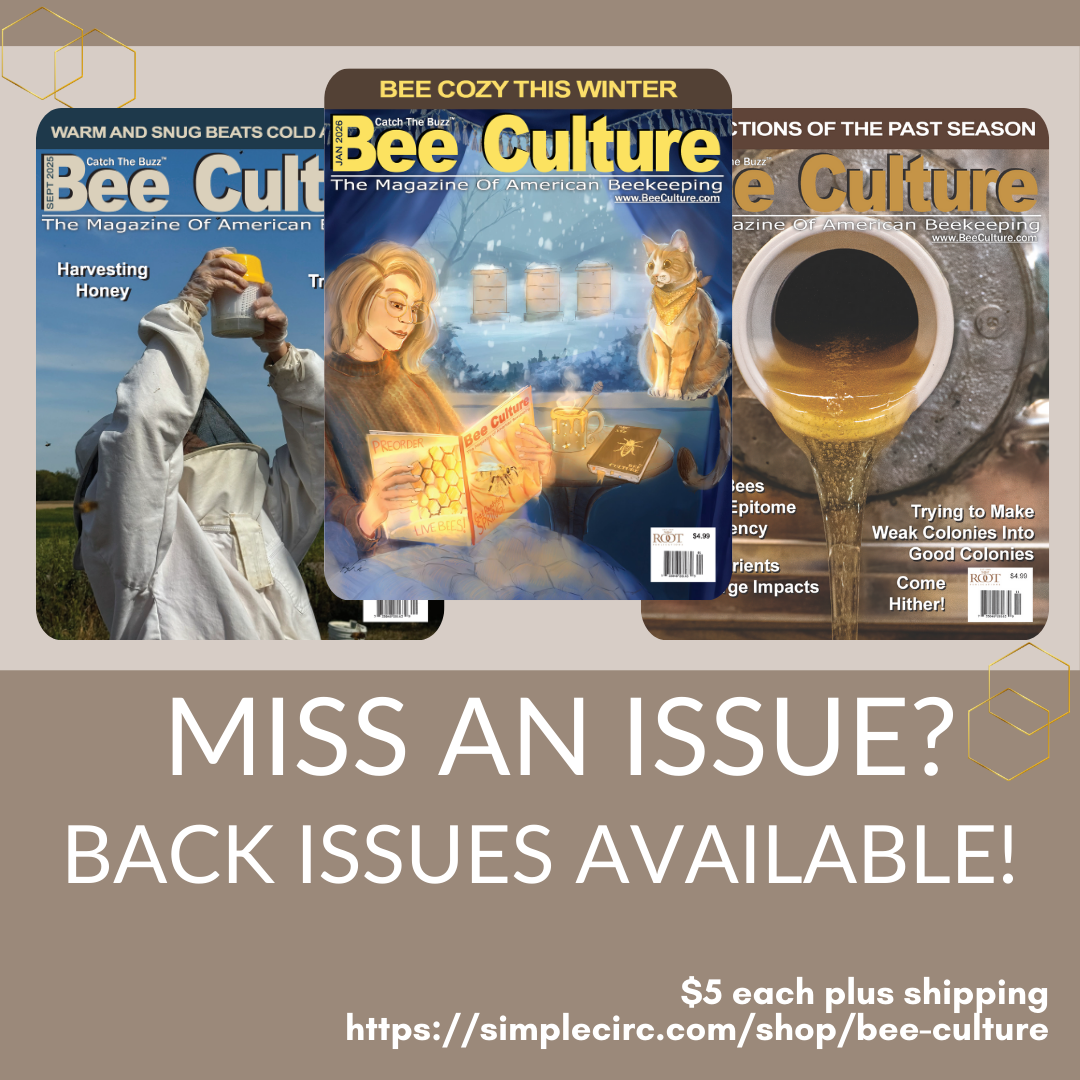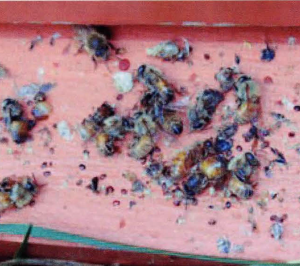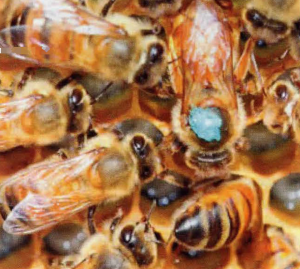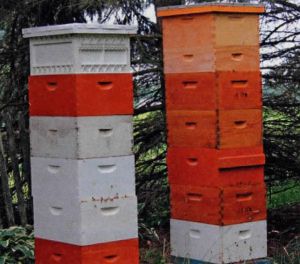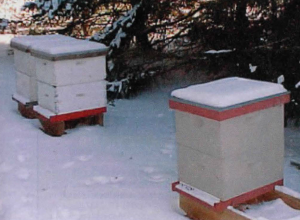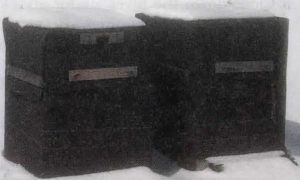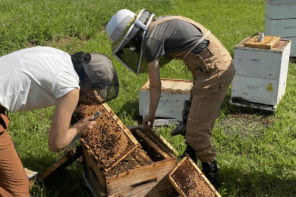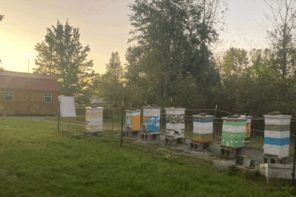By: James E. Tew
This article originally appeared in the Winter 2016 issue of BEEKeeping Your First Three Years
A cooperative effort of both bees & beekeeper
It’s all forms of management
Feeding, protecting, treating, wrapping, and still more.
Fall and Winter management is the last opportunity you will have to truly help your colonies. A quick search of my bee book library produced about a dozen books specifically on bee and hive management. Yet, with all that information and experience, managing honey bee colonies is still a relative thing and changeable task.
REMOVING THE HONEY CROP
It’s getting to be late Summer/early Fall. The 2016 spring crop is made – if you got one. Some seasons, you can do everything right and still not make a drop of surplus honey. The fading days of summer are a good time to “rob” your bees. Removing surplus honey is the procedure beekeepers go through each year when they estimate how much honey to take and how much to leave. Only experience can tell you how to deal with this situation. Take too much and your bees starve during the Winter. Leave too much, and you’ve lost part of your crop. Always err on the side of leaving too much.
So what’s the best average numbers we have? In most areas a colony probably needs about 60-70 pounds of honey during most Winters – no guarantees. An average two-story colony should weigh about 165-200 pounds. Some years this is too much while other years, the colonies may be left scant by Spring.
How are you planning to get the crop off the bees? One simple way is to brush each frame free of bees. Bee escapes of various designs can be used that do not require handling individual frames, but do require two trips to the yard – one to put escapes on and one to take supers off. Many commercial operations use “bee blowers” (devices producing large quantities of low pressure air) or chemical repellents like Bee Go (butyric anhydride). Incidentally, common leaf blowers work to blow bees from supers.
STRIP THE COLONIES
Removing honey from bee colonies should be done quickly and efficiently. After removing the crop and while the colony is open, it’s a good time to treat for Varroa mite infestations (if you are practicing Fall Varroa mite control). Varroa mite populations need to be managed just as much as honey bee populations. It is important to do something either in the early Spring or during late Summer/early Fall to control Varroa. Over time, with some successes and failures, you will acquire a feel for how well your particular control program is working.
LATE SEASON QUEEN MANAGEMENT
Fall requeening is very possible – even desirable. Consider all the problems that are currently possible in acquiring and installing new queens in the traditional Spring months. Get your queens from reputable queen producers. Most queens purchased in late Summer or early Fall have been “banked” in nursery colonies all Summer, but there’s not much you can do about that. In fact, it may not be all that harmful to the queens.
Re-queen as soon as possible after the honey is removed. Any colonies that don’t take the new queens (or are weak) should probably be combined with another colony. Try to determine why the colonies are weak. If high levels of mites seem to have caused the colony’s weakness, the chances are good that you will not be able to get it through the Winter. However, if the hive appears to be salvageable, introduce queens in the same manner as you would introduce queens in Spring months.
I like marked queens (queens with a bright dot of color on their backs). If you don’t have the time or you don’t have queen-marking experience, you can pay a bit more and most queen producers will mark the queen for you. This bright mark will help when searching for the queen.
The queen is one of the colony’s “Big Three” major components for productive hive management: (1) food stores, (2) diseases, and (3) the queen’s condition. Even if you don’t always see the queen, constantly check her progress by observing the condition and organization of the brood pattern, the characteristics of her adult workers, and the presence of eggs. Always check for the presence of eggs no matter why the colony is opened. Eggs tell you — (1) if a queen was recently present, and (2) if the queen and colony are in sync with the current season. Lots of eggs are present in late Winter/Spring while there are declining numbers of eggs during Fall and early Winter.
GENERAL MAINTENANCE
While the colony is open, and as you check for the queen or evidence of her, check the general condition of the colony. Always look for American foul brood (AFB). Any European foul brood (EFB) has probably corrected itself by now.
During the second visit after the honey has been removed, cull any bad combs. Actually, you can do that at any time that the colony is open and inspections are being made. What are bad combs? Generally, they are misshapen or distorted and have too much drone comb. Some beekeepers recommend destroying comb that is more than three to five years old. Though it should be, that procedure is not always followed. For many beekeepers destroying comb is too much work and expense for too little reward; however, old wax accumulates pesticides, environmental and in hive toxins, dirt, propolis, and “stuff.” Refreshing a super on a routine basis with new comb keeps these out of the colony and away from the bees. How about the hive bodies? Everything in order there? Remove any pieces of equipment that have rotted or need repair. Do all these repair chores during the winter while sitting beside a nice warm fire.
If you live in a warm climate and if you want increased colony numbers next Spring, making Fall splits is not a bad idea. A single story colony with honey stores, a good population of both adult bees and brood, and a new queen can stand a “warm climate” Winter quite well. In fact, in most instances, such a colony can frequently survive a cold Winter. Either way, because these colonies may need feeding, watch them in late Winter and early Spring.
THE FALL FLOW
Now, with everything discussed so far, what if a Fall nectar flow comes along? If you can get one, it’s great. Most beekeepers want to keep the Spring crop separated from the Fall crop. Though nothing is wrong with it nutritionally and honey bees readily consume it, Fall honey is usually darker and stronger flavored. Spring honey is usually typically preferred by honey customers.
Managing bees for a fall crop is much like the management recommendation for a Spring crop. Get the supers on before the flow and keep them coming as long as the bees need the storage space. One change that should be considered is to remove most, if not all, the supers before the Fall flow is over. You want the bees to really pack out the two brood bodies with ripened honey. That will be your bees’ rations for the upcoming Winter. Many beekeepers don’t like to winter colonies on Fall stores. Supplemental feeding may be necessary in order to get the colonies up the desired gross weight.
EXTRACTING THE CROP
At this point in this discussion, several things could have happened with the year’s honey crop: (1) You extracted the Spring crop during the Summer and all is finished; (2) You are presently preparing to extract the Spring crop in the Fall; or (3) you have both a Spring and Fall crop with which to deal. That’s neither good nor bad, but simply a fact of beekeeping — honey must eventually be extracted or at least processed in some way.
Extracting the crop is not really beekeeping, but something more like specialty food processing. All the bee biology in the world won’t help you understand how to design a filter system for an extracting layout. Extractors for small operations can be anything from a (new) modified plastic garbage can to a sophisticated computerized extracting device that will run 40 – 60 frames per cycle. The point is that at this time in late Summer/early Fall, most beekeepers make the change from managing bees to processing honey, only the scale varies.
As with stinging episodes, most beekeepers have their own extracting horror story that, in some way, concerns a runaway honey processing system in the kitchen or 2000 gallons spilled on the extracting plant floor. We all get our stories soon enough.
ORDER YOUR PACKAGES
Can you believe it? By the time September or October rolls around, you’d better be ordering your packages for the next Spring season. Bee times have changed. Increasingly, package producers have been struggling to stay up with demand. The early beekeeper gets the package bees from the right producer at the right time.
STAY INFORMED
Something else that usually happens during August or September are the Fall beekeeper meetings. You may have heard much of what is said at bee meetings, but there are so many new beekeepers that it needs to be said again (and again). It is critical to stay informed on all bee science updates and not just those on mite control or pesticide issues. The successful beekeeper is informed with good, dependable knowledge. If your state doesn’t have a late Summer or Fall meeting, consider going to one of the regional or national meetings. It will be good for you to get information on the “bigger” beekeeping picture.
WINTER PREPARATIONS
Once the Fall flow is over, timely beekeeping practices become important. But what is timely? When is the actual critical time to begin preparing colonies for Winter? Surprisingly, there are no absolute deadlines. Many hard-core wintering procedures can be done in August or September anywhere in the United States without ill consequences.
Many times, bee colonies can survive quite well with no help at all from beekeepers, but that’s simply leaving too much to good luck and chance. In warm climates, you can begin Winter preparations in October or even early November.
In cool climates, begin Winter preparations in September or early October. Ironically getting entrance reducers in place is one of the most demanding events. Entrance reducers keep mice out of the hive. Mice, too, must make Winter preparations, and unlike us, they stay on schedule. Their successful Winter survival depends on finding a warm dry place to pass the Winter. A beehive is a perfect wintering site for mice. However, mice are inconsiderate hive guests. They chew up comb. They defecate inside the hive, and they keep the colony disrupted. Over a long Winter, they can really wear out their welcome. Entrance reducers must be in place before the mice take up residence. That is the reducer’s purpose — to keep out mice, not to keep out the cold.
Late Summer/early Autumn is a good time to standardize and organize a yard. Get your colonies off the ground, fix gates or fences that surround the colonies. Cut back over-hanging limbs, and straighten up colonies that are out of plumb, making sure the back is just a bit higher than the front. It’s so much easier to do these maintenance type things before the weather gets cold.
So long as you are tidying things up in the yard, how’s the paint on the hives? Use latex paint and don’t put it on when it’s below 40° F outside. Painting does not just keep colonies neat, but it also protects the wood from water penetration. Lumber costs have climbed so high that the labor and expense of painting hive equipment is generally worth the effort.
If hives are to be packed (insulated), you can get on with that at this time, too. Most beekeepers don’t pack their colonies, but it’s still an accepted practice. In years past, hives in cool or cold climates were packed and wintered outside, or they were put into cellars (cellaring) built for that purpose. Then and today, the cellars had to stay around 40-50° F, and have provisions for significant air movement. It would appear that cellaring bees was too much work with erratic results. Cellar wintering bee hives is uncommon now. However, there are always those who want to try “Winter packing” hives.
Winter wrapping devices can be purchased from bee supply companies, or you can wrap your hives in black roofing felt. The black felt absorbs heat and keeps cold air out of cracks and crevices in the hive walls. Don’t use true insulation. It absorbs water and becomes soggy. I’ll bet you (with no data) that a piece of Styrofoam beneath the bottom board and beneath the outer cover would help the bees a bit.
PROVIDE VENTILATION
Even if no insulation is used, warm air rising off the cluster has more water vapor than can be held as the air cools. It condenses within the hive. Though I have recommended previously the reduction of the bottom entrance, now I am suggesting new top entrance – probably about a quarter to three eighths of an inch beneath the inner cover. Two Winter things happen at this point: (1) air can circulate (and escape) thereby stopping condensation from forming within the hive; and (2) the bees are given an upper entrance. This top entrance is useful in cold climates where snow and ice may block the lower entrance.
SPEAKING OF THE INNER COVER
It should be turned over so that the deep side is down, but don’t do this until the Fall flow is over. The deep side of the inner cover gives the bees more space to cluster over the frame top bars and thereby distribute Winter food more easily throughout the hive. If this procedure is not done, colony life will go on; but it is one of those little things that is helpful to bees. Now, here’s the rub. If you reverse the inner cover, you must be back there in late Winter to turn it back over before the Spring flow starts. Obviously, the bees would fill this space with burr comb and honey causing a bit of a mess to clean. Remember, deep side down during cold months and shallow side down during warm months.
COLONY LIFE
As you work your way through your colonies during late Summer, watch for any that are light in honey stores. It must be said that all seasons are not surplus years. Sometimes the hives just don’t get a good flow. If a colony appears to be light, but otherwise healthy, feed it thick syrup. To dissolve sugar into a solution, syrup this heavy will require some heat. The syrup made for Spring stimulation can be tap water warm, but that doesn’t work well for Winter stores. There are many types of feeders that you can use to get Winter feed to the hives, but any feeder should: (1) supply only the amount the bees can take before fermentation occurs; (2) be readily usable by the bees; and (3) not incite robbing.
ROBBER BEE CONTROL
Once the Fall flow is past, you should be alert for robbing activities – especially as you manipulate colonies. During a good flow, almost anything goes – requeening, supering, or making splits – all without much concern by the bees. But once the flow is over, “Thy neighbor’s food supply is fair game”. You won’t miss the symptoms of robbing. Bees will be fighting while others frantically try to get into the hive at any crack within the hive walls. Close down the hives under attack. Simply stuff grass into all the hive openings. Better yet – move the colony to another location where competition is not so stiff.
CONTROLLING SKUNKS, RACCOONS, AND OTHER SUCH PESTS
Small animals can be a significant nuisance to wintering colonies. In the case of small pests like skunks and raccoons, get the hives off the ground or fence them. In any case, do something before the colony goes into hard Winter. Continued Winter disruptions from critters like these keep the colony agitated both day and night.
In managing your bees during late Summer and early Fall, as always, do no harm. In our efforts to help, we all, to often, injure more than we help. From this discussion, select the items that you think will help you and your bees close down one season and prepare for another. Hive management is just one big cooperative cycle between you and your bees.




